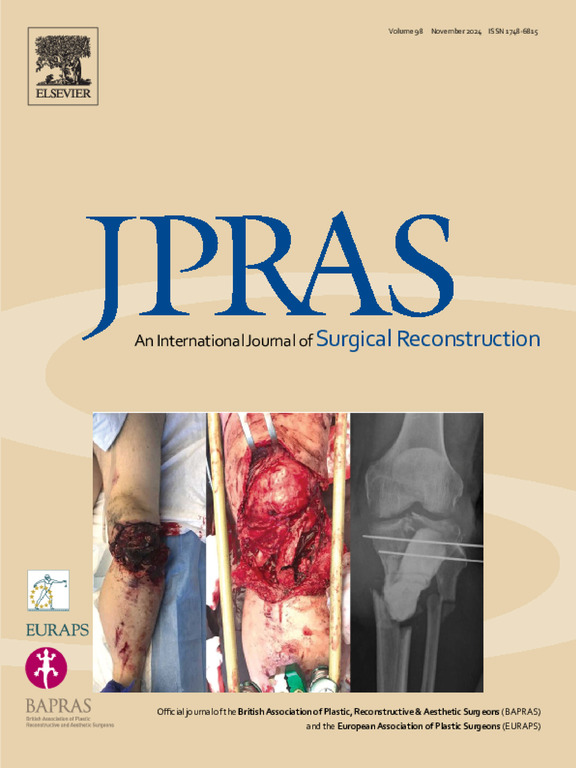Venous outflow augmentation protects against fat necrosis in the DIEP flap breast reconstruction: A retrospective analysis
IF 2.4
3区 医学
Q2 SURGERY
Journal of Plastic Reconstructive and Aesthetic Surgery
Pub Date : 2025-08-20
DOI:10.1016/j.bjps.2025.08.019
引用次数: 0
Abstract
Background
In the deep inferior epigastric perforator (DIEP) flap breast reconstruction, fat necrosis is a common and distressing complication for patients. While venous outflow augmentation using the superficial inferior epigastric vein (SIEV) has been suggested to improve some perfusion-related outcomes, its effect on fat necrosis remains insufficiently substantiated.
Methods
A retrospective review was conducted of unilateral, unipedicled DIEP flap breast reconstructions performed between 2012 and 2023 at a tertiary centre in London, United Kingdom. Patients were categorised based on SIEV venous augmentation status, and the incidence of postoperative clinical fat necrosis was recorded. Univariable and multivariable logistic regression models assessed the relationship between fat necrosis and SIEV augmentation, as well as patient, surgical and perfusion-related factors.
Results
The total cohort included 119 patients (119 flaps). Of the total flaps, 58.8% received venous augmentation with the SIEV. Fat necrosis occurred in 16.8% of the total cases. Patients in the SIEV-augmented group experienced significantly lower fat necrosis rates compared to controls (10.0% vs. 26.5%, respectively; P = 0.025). Multivariable analysis further demonstrated a protective effect from SIEV augmentation against fat necrosis (adjusted odds ratio 0.33, 95% confidence interval 0.12–0.95; P = 0.039).
Conclusions
In the present cohort of DIEP flap breast reconstructions, venous augmentation using SIEV was a significant independent protective factor against fat necrosis. While prospective studies are necessary to validate this relationship, this technique may be considered as part of routine surgical practice in eligible cases.
静脉流出增强对DIEP皮瓣乳房重建中脂肪坏死的保护:回顾性分析
背景:在腹下深穿支皮瓣乳房重建术中,脂肪坏死是常见且困扰患者的并发症。虽然使用上腹部浅下静脉(SIEV)增强静脉流出已被认为可以改善一些灌注相关的结果,但其对脂肪坏死的影响仍未得到充分证实。方法回顾性分析2012年至2023年在英国伦敦某三级医疗中心进行的单侧、单蒂DIEP皮瓣乳房重建手术。根据SIEV静脉增强状态对患者进行分类,并记录术后临床脂肪坏死的发生率。单变量和多变量logistic回归模型评估了脂肪坏死与SIEV增强之间的关系,以及患者、手术和灌注相关因素。结果共纳入119例患者(119个皮瓣)。在所有皮瓣中,58.8%的皮瓣接受了SIEV静脉增强。脂肪坏死占总病例的16.8%。与对照组相比,siev增强组患者的脂肪坏死率显著降低(分别为10.0%对26.5%;P = 0.025)。多变量分析进一步证明了SIEV增强对脂肪坏死的保护作用(校正优势比0.33,95%可信区间0.12-0.95;P = 0.039)。结论在DIEP皮瓣乳房重建术中,SIEV静脉增强术是预防脂肪坏死的重要独立保护因素。虽然需要前瞻性研究来验证这种关系,但在符合条件的病例中,该技术可被视为常规手术实践的一部分。
本文章由计算机程序翻译,如有差异,请以英文原文为准。
求助全文
约1分钟内获得全文
求助全文
来源期刊
CiteScore
3.10
自引率
11.10%
发文量
578
审稿时长
3.5 months
期刊介绍:
JPRAS An International Journal of Surgical Reconstruction is one of the world''s leading international journals, covering all the reconstructive and aesthetic aspects of plastic surgery.
The journal presents the latest surgical procedures with audit and outcome studies of new and established techniques in plastic surgery including: cleft lip and palate and other heads and neck surgery, hand surgery, lower limb trauma, burns, skin cancer, breast surgery and aesthetic surgery.

 求助内容:
求助内容: 应助结果提醒方式:
应助结果提醒方式:


